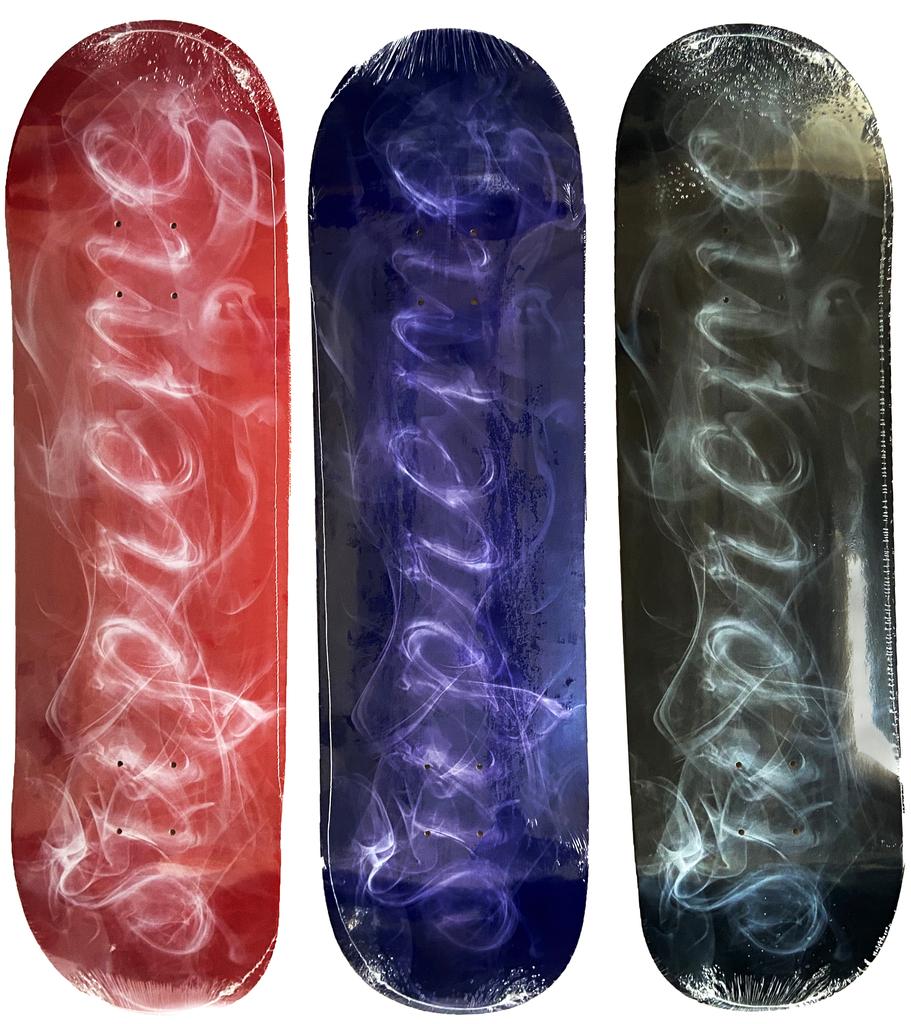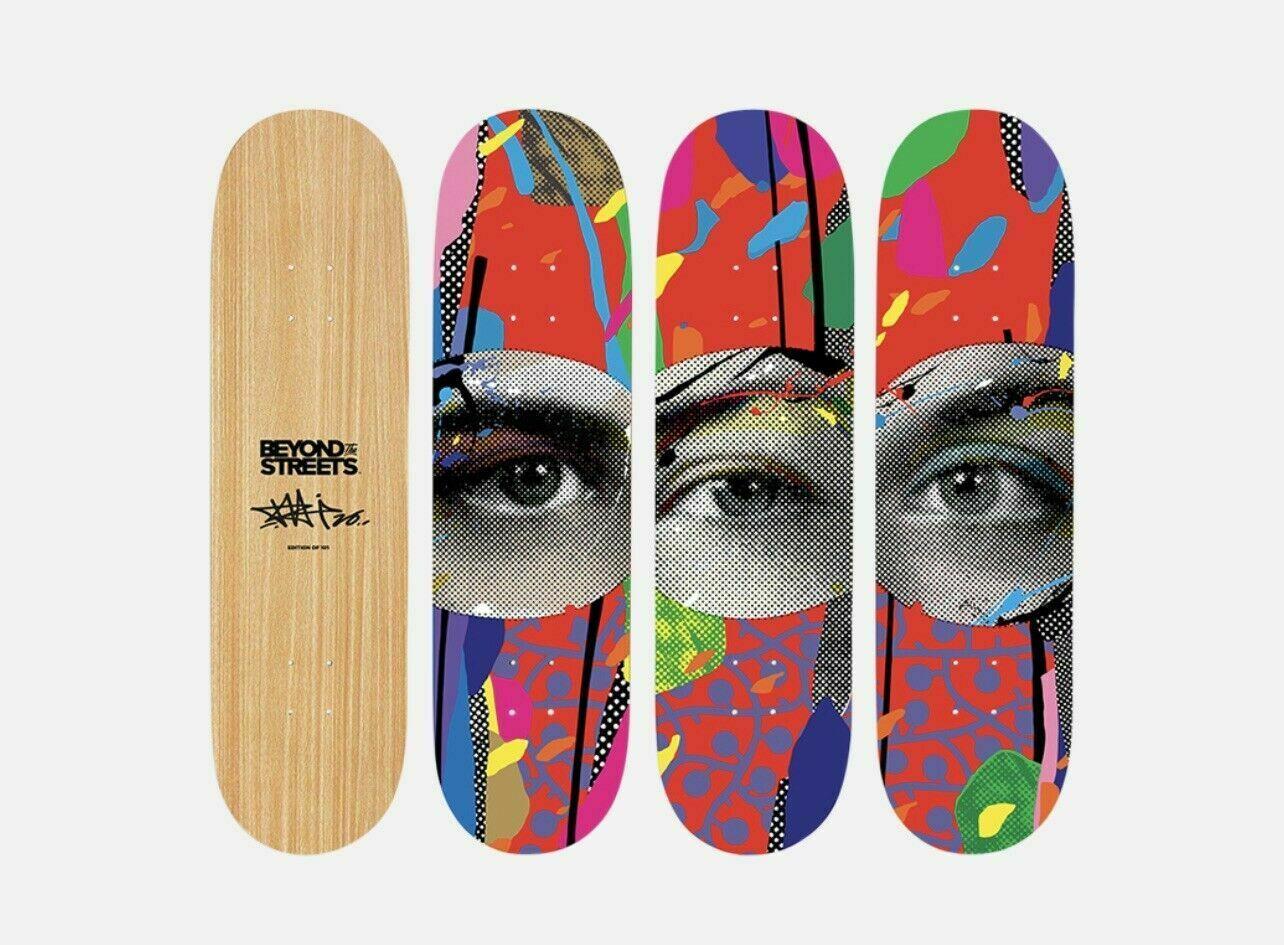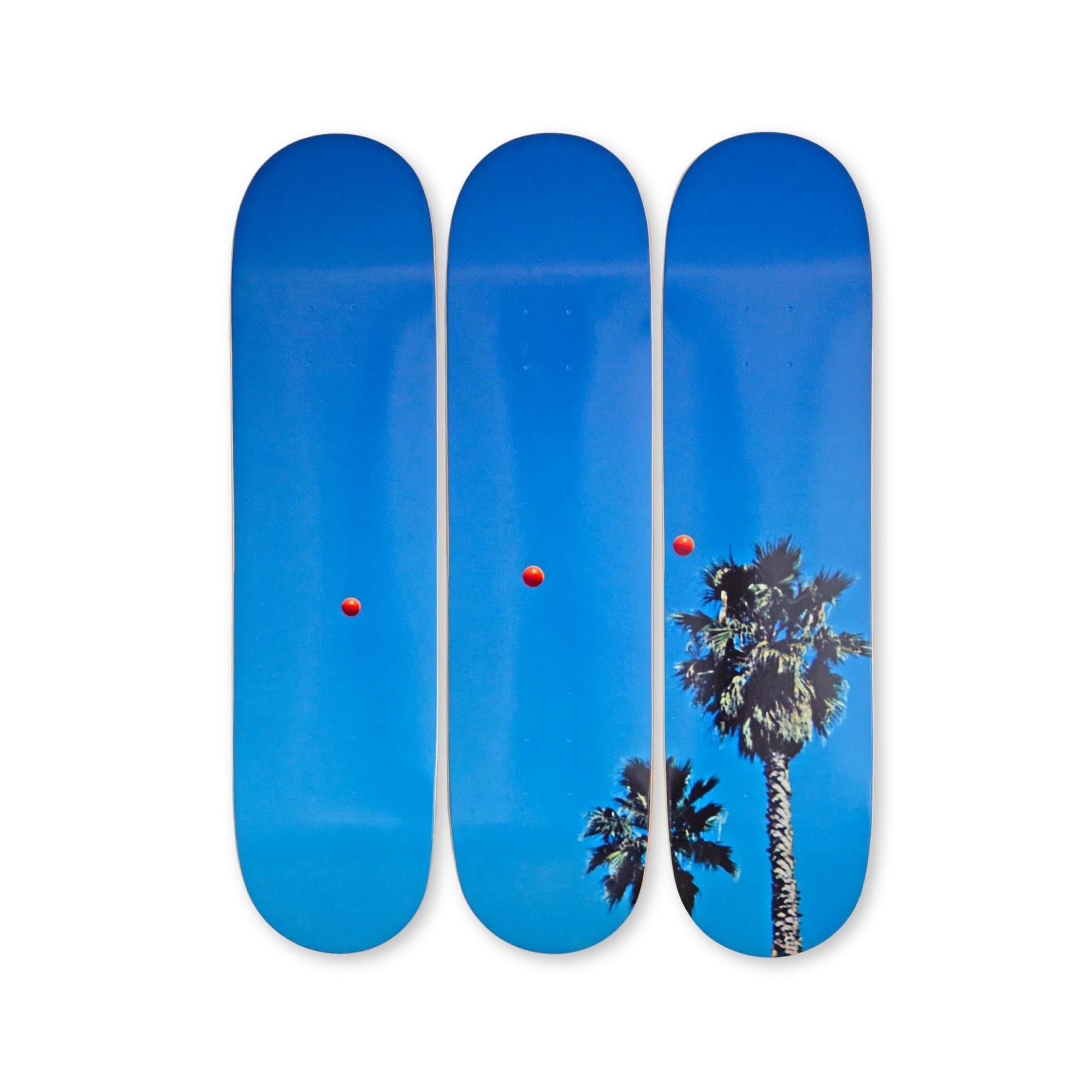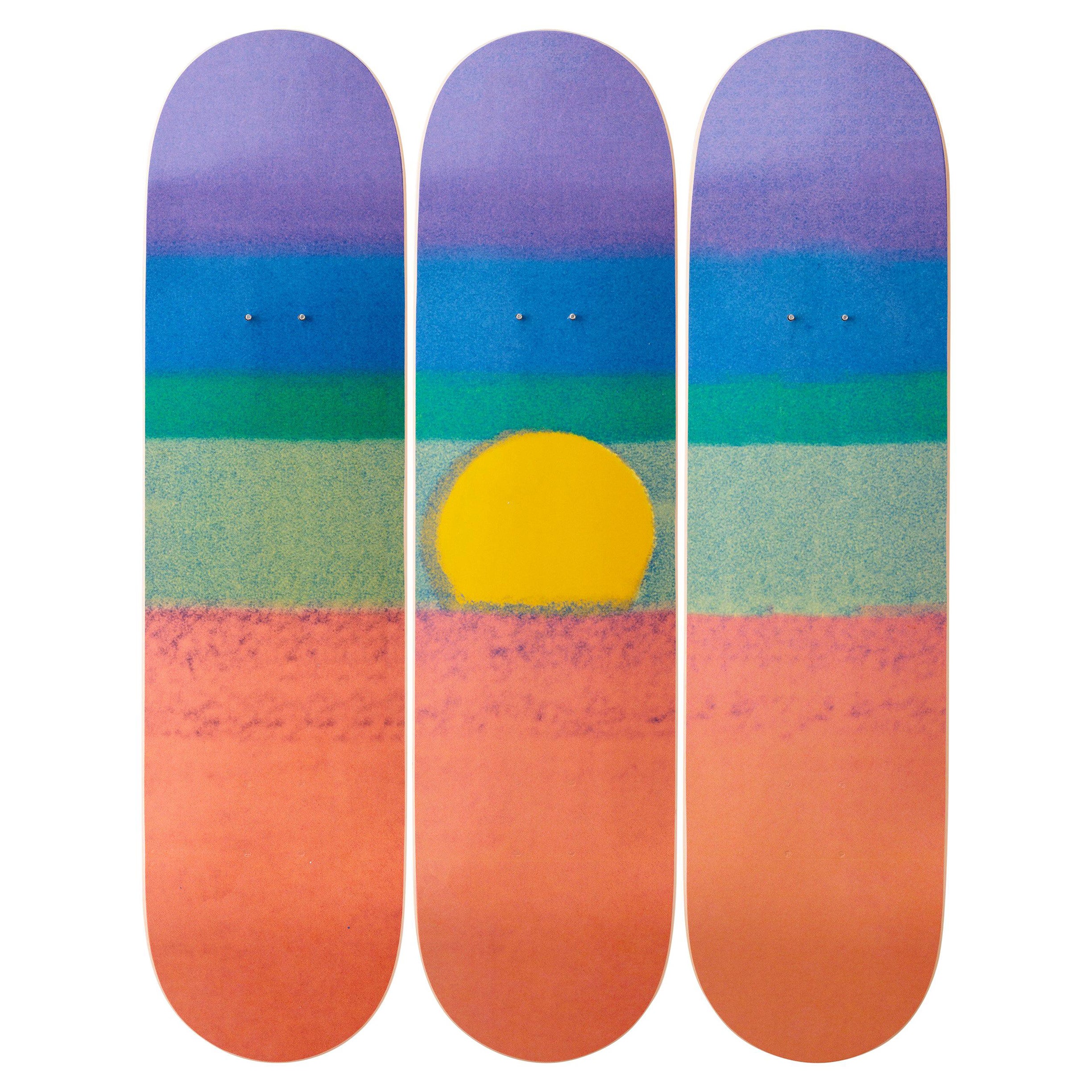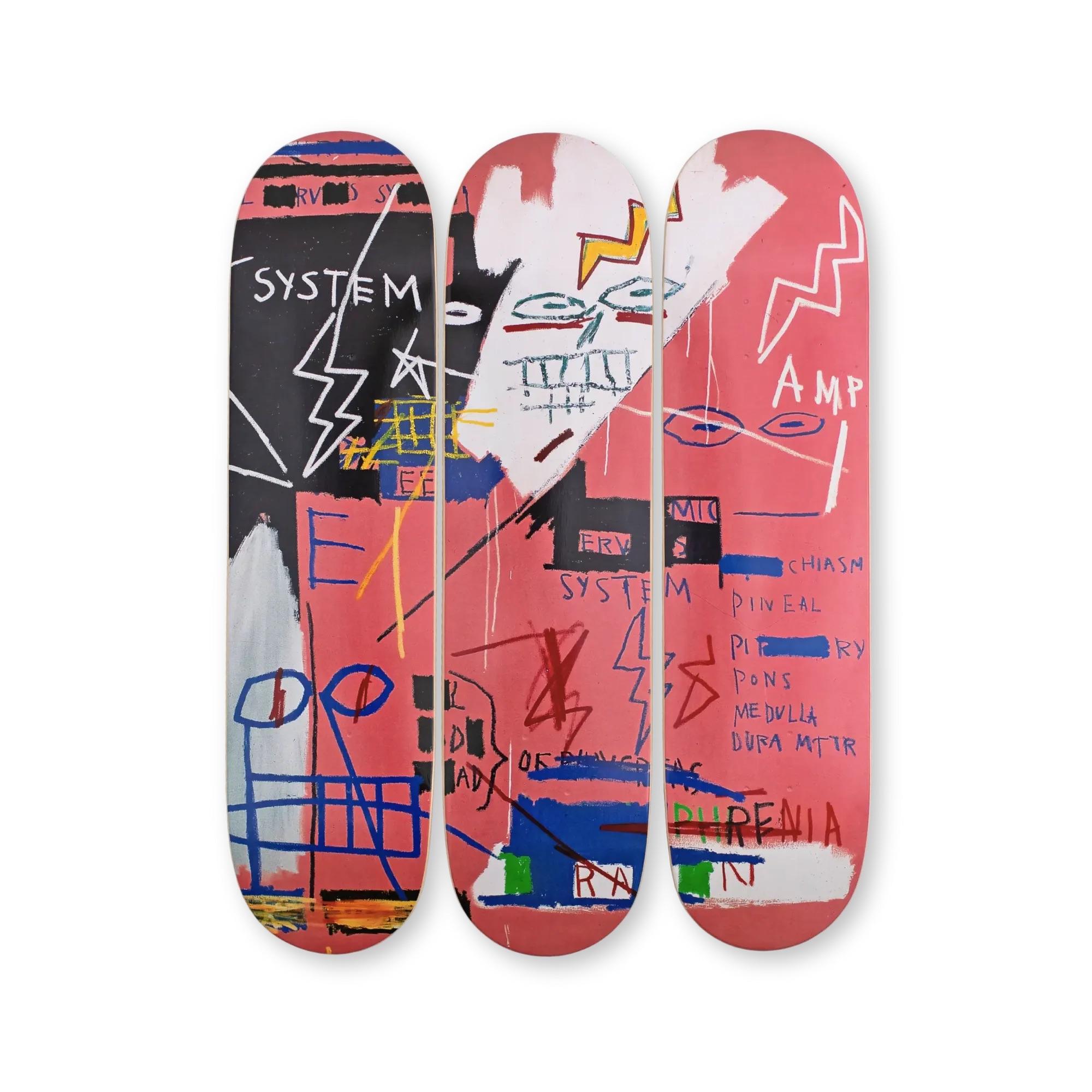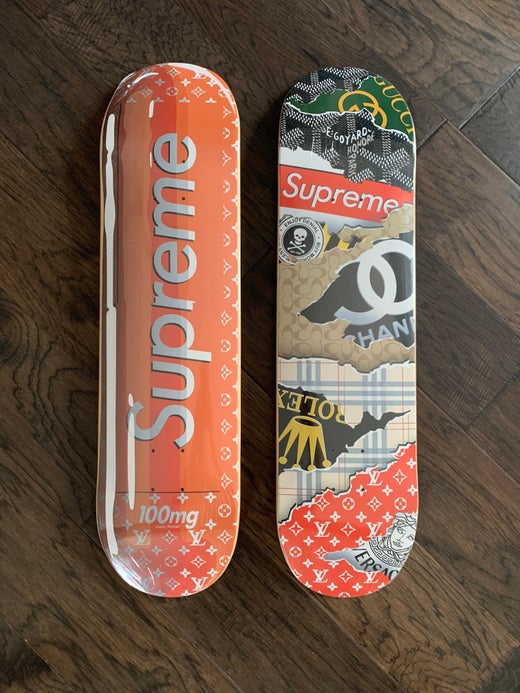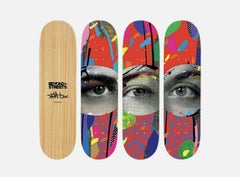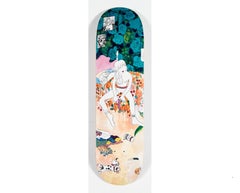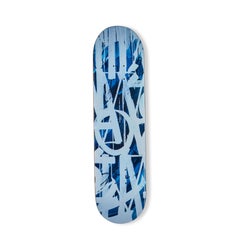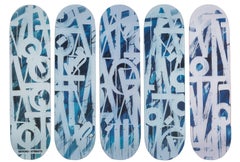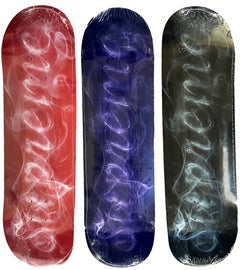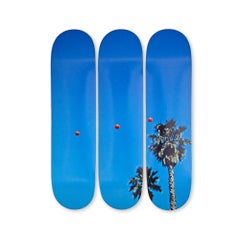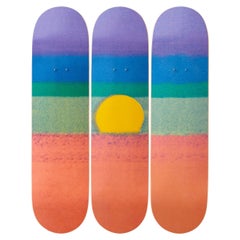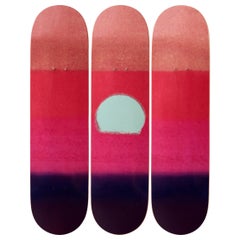Items Similar to Denial Alternative Medicine Screenprint on Skatedeck Complete Set of 3 Jordan
Want more images or videos?
Request additional images or videos from the seller
1 of 4
DenialDenial Alternative Medicine Screenprint on Skatedeck Complete Set of 3 Jordan2021
2021
$1,499
£1,162.61
€1,317.77
CA$2,145.33
A$2,344.21
CHF 1,215.32
MX$28,004.94
NOK 15,465.65
SEK 14,479.52
DKK 9,840.06
About the Item
Denial's "In Patient", "Out Patient", and "Alternative Medicine" art pieces are a stunning set of 3 archival pigment print transfers on cold pressed steep natural skate decks, each measuring 8.25 x 31.875 inches in dimensions. This limited edition set is hand-numbered and comes with a certificate of authenticity from both the artist and publisher, 1xRUN.
Denial, also known as Daniel Bombardier, is a Canadian artist whose work spans across various mediums, including graffiti, street art, and fine art. His art is known for its satirical and ironic take on consumerism, politics, and societal issues. Denial's art often features bold graphics and imagery that make a strong statement and provoke thought.
The "In Patient", "Out Patient", and "Alternative Medicine" pieces are no exception. Each deck features a different graphic, yet all three are linked by a common theme of questioning our society's relationship with mental health and the pharmaceutical industry.
The choice of medium for these pieces is also significant. Skate decks have a long history in both street art and skate culture. They are a perfect canvas for Denial's graphic and bold imagery, and the use of archival pigment print transfers ensures that the graphics will last for years to come.
Overall, Denial's "In Patient", "Out Patient", and "Alternative Medicine" pieces are a powerful and thought-provoking set of artwork. They showcase Denial's signature style and his ability to make a statement through his art. This limited edition set is a must-have for any collector of street art or contemporary art.
- Creator:Denial (1976, Canadian)
- Creation Year:2021
- Dimensions:Height: 31.875 in (80.97 cm)Width: 8.25 in (20.96 cm)Depth: 0.1 in (2.54 mm)
- Medium:
- Period:
- Condition:
- Gallery Location:Draper, UT
- Reference Number:1stDibs: LU132729274552
Denial
Denial, also known as Daniel Bombardier, is a Canadian street artist known for his bold and satirical works that comment on consumer culture and the human condition. He was born on May 27, 1976, in Windsor, Ontario, Canada. Denial's artistic practice is characterized by his use of iconic imagery and text, often re-appropriated in unexpected and humorous ways. His works feature recognizable brands and logos, altered to convey messages of social and political commentary. Denial's works have been exhibited in galleries and museums around the world, including the Museum of Contemporary Art in Detroit and the Celaya Brothers Gallery in Mexico City. He has also created large-scale murals and public installations in cities across North America. In addition to his work as a street artist, Denial is also an accomplished graphic designer and illustrator, creating album covers, posters, and merchandise for a variety of clients. Denial's works continue to challenge and provoke audiences with their clever and irreverent approach to contemporary art and culture. He remains an influential figure in the street art movement, inspiring a new generation of artists to use their creativity to make a difference in the world.
About the Seller
5.0
Gold Seller
Premium sellers maintaining a 4.3+ rating and 24-hour response times
Established in 2002
1stDibs seller since 2019
234 sales on 1stDibs
Typical response time: <1 hour
- ShippingRetrieving quote...Shipping from: Orlando, FL
- Return Policy
More From This Seller
View AllPaul Insect I SEE Skateboard Deck Set Of 3 Beyond The Streets Signed XX/101 COA
By Paul Insect
Located in Draper, UT
Paul Insect:
Paul Insect is a UK contemporary artist. Best known for his collective named ‘insect’ that started in 1996 he is a collage, portrait master w...
Category
2010s Pop Art More Prints
Materials
Screen
Supreme with Japanese Artist Auto Moai Collaboration Screenprint on Skatedeck
Located in Draper, UT
Offset lithograph in colors on skate deck
32 × 8 in
81.3 × 20.3 cm
Category
2010s Still-life Prints
Materials
Wood Panel, Screen
RETNA X BTS Silkscreen Skateboard Edition of 250
By RETNA
Located in Draper, UT
RETNA X BTS Silkscreen Skateboard Edition of 250
2018
Limited edition
Silkscreen on maple wood skateboard deck.
31 × 8 × 1 in
78.7 × 20.3 × 2.5 cm
Edition of 250
Comes with Certifica...
Category
2010s Street Art More Art
Materials
Wood, Screen
RETNA X Beyond the Streets Complete Set of Skate Decks
By RETNA
Located in Draper, UT
Up for sale is a complete set of skate decks featuring offset lithographs in colors by the renowned artist Retna. This set, produced by Beyond the Streets...
Category
2010s More Art
Materials
Wood
Unfinished Business SkateDeck
Located in Draper, UT
Joshua Vides, Unfinished Business Skate Deck in original packaging.
Category
2010s Street Art Mixed Media
Materials
Wood
Limited Edition Felipe Pantone Skate Deck Vaporwave Aesthetic Optichromie 122
By Felipe Pantone
Located in Draper, UT
Felipe Pantone "Optichromie 122"
Ltd Ed. Skate Deck. Dead Stock Sealed Like New Condition.
Produced for Beyond the Streets NTWRK 2020- by Co-Curator F...
Category
2010s Contemporary Prints and Multiples
Materials
Screen
You May Also Like
SUPREME skateboard deck set of 3 works (Supreme skate decks 2019)
By Supreme
Located in NEW YORK, NY
Supreme Skateboard Decks complete Set of 3 works, 2019:
A stand out skate triptych set featuring the Supreme logo in smoke letters. Features a printed World Famous Supreme logo. Each...
Category
21st Century and Contemporary Pop Art More Art
Materials
Wood, Screen
JOHN BALDESSARI - Throwing Three Balls... Skate Deck Modern Design Contemporary
By John Baldessari
Located in Madrid, Madrid
JOHN BALDESSARI - Throwing Three Balls in the Air to get a Straight Line (Best of Thirty-Six Attempts)
Date of creation: 2025
Medium: Digital print on Canadian maple wood
Edition: 3...
Category
2010s Expressionist More Art
Materials
Wood, Maple, Screen
Sunset ‘Orange’ Skateboard Decks After Andy Warhol
By (after) Andy Warhol
Located in Jersey City, NJ
The Skateroom with the Andy Warhol Foundation
Set of three skateboard decks
7-ply Canadian maplewood with screenprint
Measures: Each: 31 H x 8 inches
Approx. 31 H x 24 inches whe...
Category
2010s Belgian Wall-mounted Sculptures
Materials
Maple
Sunset 'Purple' Skateboard Decks after Andy Warhol
By (after) Andy Warhol
Located in Jersey City, NJ
The Skateroom with the Andy Warhol Foundation
Set of three skateboard decks
7-ply Canadian Maplewood with screenprint
Measures: Each: 31 height x 8 inches
Approx. 31 height x 24 ...
Category
2010s Belgian Wall-mounted Sculptures
Materials
Maple
JEAN-MICHEL BASQUIAT - Six Fifty. Skate Decks Pop Urban Art Design
By Jean-Michel Basquiat
Located in Madrid, Madrid
Jean-Michel Basquiat - Six Fifty
Date of creation: 2024
Medium: Digital print on Canadian maple wood
Edition: Open
Size: 80 x 20 cm (each skate)
Condition: In mint conditions and never displayed
This triptych is formed by three skate decks made of 7 ply grade A Canadian maple wood.
© Estate of Jean-Michel Basquiat. Licensed by Artestar, New York
Six Fifty (1982) powerfully distills the symbolic universe and raw energy that define Jean-Michel Basquiat’s artistic language. In this piece, the artist uses a loaded iconography—lightning bolts, bones, swords, arrows, crowns—that serves as a kind of visual alphabet through which he explores themes of identity, violence, power, and cultural heritage.
With his gestural and spontaneous style, Basquiat turns the canvas into a field of tension between chaos and control, between the urgency of the street and the depth of critical thought. Like much of his work, this piece does not seek a single interpretation but instead opens multiple layers of meaning through graphic elements that seem to arise directly from the urban subconscious.
Six Fifty is not just a visual representation—it is a visceral statement, a fragment of the noise and pulse of 1980s New York, where Basquiat emerged as a radical voice in contemporary art. His ability to combine the immediacy of graffiti with historical, anatomical, and cultural references is fully evident here.
ABOUT THE ARTIST
Jean-Michel Basquiat (1960-1988) was one of the most influential artists of the 20th century, famous for his ability to fuse urban culture, social criticism and art history into a unique style. Born in Brooklyn, New York, to a Haitian father and Puerto Rican mother, his life and work were shaped by his multicultural heritage, the New York art scene and the social tensions of his time. Although his career was brief, his impact on contemporary art has been lasting and significant.
Basquiat showed an interest in art from an early age. His mother, Matilde Andrades, took him to museums and encouraged him to draw. At the age of seven, a car accident left him hospitalized for a time, and it was then that his mother gave him a copy of the anatomy book Gray's Anatomy, which influenced his fascination with the human body and its visual representation.
Despite his early talent, Basquiat's family life was turbulent. His mother was hospitalized for psychiatric problems and his relationship with his father, Gerard Basquiat, was troubled. This instability contributed to Basquiat dropping out of school at age 17 to pursue his artistic career on the streets of New York.
As a teenager, Basquiat joined the New York graffiti scene under the pseudonym SAMO (an acronym for "Same Old Shit"), which he used to sign his cryptic and poetic messages on the streets of Manhattan with his friend Al Diaz. SAMO's graffiti were a mixture of philosophical and social commentary on popular culture, capitalism and religion, and soon attracted the attention of the underground art scene.
In 1980, SAMO "died" when Basquiat and Diaz decided to end their collaboration, marking the beginning of Basquiat's transition from street graffiti to art galleries.
Basquiat emerged as a talent to watch in 1980, when he participated in the group exhibition The Times Square Show, which included other emerging artists from New York's Lower East Side scene. That same year, he attracted the attention of critics and collectors who saw in his work an electrifying blend of street art and neo-expressionism, the predominant movement of the time.
In 1981, art critic René Ricard published the influential essay The Radiant Child in Artforum magazine, which positioned Basquiat as one of the most promising artists of his generation. Shortly thereafter, he met renowned artist Andy Warhol, with whom he formed a close friendship and significant artistic collaboration. This association was instrumental in catapulting his career into the world of high art.
The collaboration with Warhol was a pivotal point in Basquiat's career. The two artists, although coming from very different worlds, shared a fascination with fame and popular culture. Together, they produced a series of works that combined Warhol's pop art icons with Basquiat's raw, spontaneous style.
However, this collaboration was also a source of controversy. Many critics accused Warhol of "exploiting" Basquiat, while others saw the collaboration as a creative dialogue between two genius minds. Although the criticism was mixed, there is no doubt that the relationship between the two artists helped cement Basquiat's reputation in the art world.
Basquiat's style is a unique amalgam of influences. His work is characterized by the use of dismembered human figures, skeletons and internal organs, evoking the fragility of the body and mortality. Basquiat also used symbols that alluded to African-American and African history, such as crowns, masks and references to historical figures such as Toussaint Louverture.
The use of text is another crucial aspect of his work. Words, phrases and numbers appeared in his paintings, often crossed out or overlapped, creating a sense of controlled chaos. These fragmented words provoked a non-linear reading of his works and conveyed multiple layers of meaning.
His art also reflected his concerns about racial issues, especially the place of people of African descent in Western art history and in society at large. The crowns that Basquiat often drew on his figures were a symbol of power and resistance, a way of proclaiming himself "king" in a world that had historically excluded black artists from the upper echelons of art.
In works such as The Death of Michael...
Category
2010s Pop Art More Art
Materials
Wood, Digital
ANDY WARHOL SUNSET (ORANGE) Skate Deck Pop Art Modern Design
By Andy Warhol
Located in Madrid, Madrid
after Andy Warhol - SUNSET (ORANGE)
Date of creation: 2019
Medium: Digital print on Canadian maple wood
Edition: 500
Size: 80 x 20 cm (each skate)
Condition: In mint conditions and n...
Category
2010s Pop Art More Art
Materials
Wood, Maple
More Ways To Browse
Metropolitan Museum Of Art Tiffany Stained Glass
Owen Bowen
Oxford Limited
Paul Insect
Peter Blake Alphabet
Picasso Faunes Et Flores
Picasso Vallauris Poster
Pose Jordan Nickel
Poster Maroc Vintage
Poster Maroc
Poster Ville Vintage
Princess Leia
Prints Of Maurice Utrillo
Renoir Poster
The Angelus
Valentine Hugo
Victorian Greenhouse
Vintage Dahlia Print
